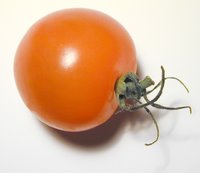This essay from the New York Times is a moving portrayal of why organic farming is so costly - personally and financially. It's a shame that with all the hard work that goes into organic produce, the fruits and veggies themselves still end up being infested a lot of the time (see Jordan's comment on my previous post).
I guess they often don't look as pleasing either: brown spots and odd shapes are more common in organic produce - this shouldn't bother us but we have been well-trained to select the healthiest-looking food for ourselves: in a very modern way this would be designed to get value for money and in a very ancient was this would have been a survival technique.
 Too bad that the healthiest-looking fruit these days often tastes a bit like cardboard. A stanford prof explains that tomatos are usually picked before they're ripe (so that they aren't soft and squishable as they travel across the continent) and then made to look red and ripe (sadly without the usual sugar infusion you get with natural ripening) using ethylene. Yum, ethylene-tomatoes. I wonder if exposure to ethylene would prevent a tomato from being classified as being organic?
Too bad that the healthiest-looking fruit these days often tastes a bit like cardboard. A stanford prof explains that tomatos are usually picked before they're ripe (so that they aren't soft and squishable as they travel across the continent) and then made to look red and ripe (sadly without the usual sugar infusion you get with natural ripening) using ethylene. Yum, ethylene-tomatoes. I wonder if exposure to ethylene would prevent a tomato from being classified as being organic?The same prof explains that some companies are trying to get around this problem by modifying the tomatoes' genes to alter the ripening process. I wonder what the per tomato cost will be to make them look good and travel well compared to the per tomato cost to farm tomatoes organically and locally?
...adjusted to reflect the relative nutritional value and environmental imact of creating each tomato of course. Which would be an complex thing to figure out.
No comments:
Post a Comment